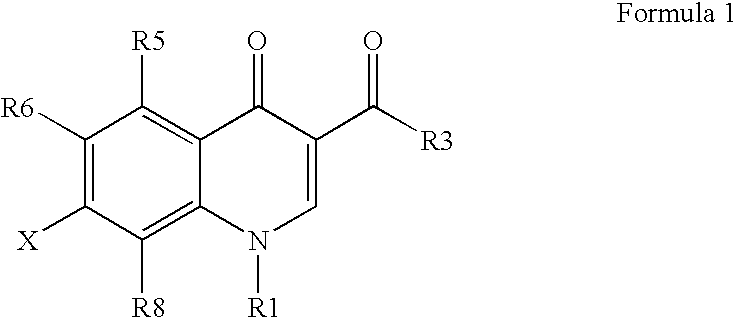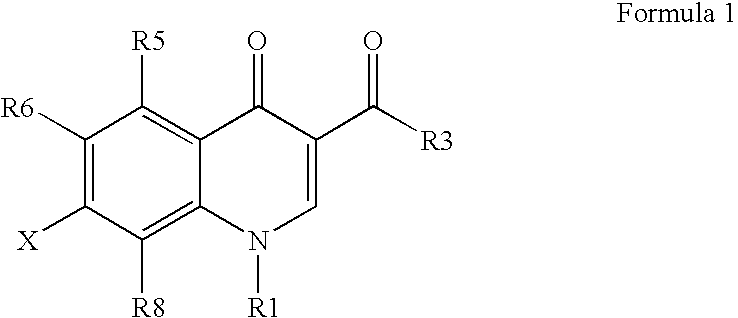Antimicrobial quinolones, their compositions, and uses
a technology applied in the field of antimicrobial compounds, can solve the problems of quinolones and quinolonyl compounds that defy the art accepted structure/activity relationships, and achieve the effect of limited capacity in overcoming
- Summary
- Abstract
- Description
- Claims
- Application Information
AI Technical Summary
Benefits of technology
Problems solved by technology
Method used
Image
Examples
example a
PRECURSOR EXAMPLE A
3-Chloro-2,4-difluoro-bromobenzene
[0112] To a solution of 19 ml (0.135 mole) of diisopropylamine in 125 ml of tetrahydrofuran (THF) cooled at −20° C. is added 80 ml of n-butyllithium (1.6 M in hexane). The temperature is raised to 0° C. for 5 minutes and lowered to −78° C. Then 25 g (0.129 mole) of 2,4-difluoro-bromobenzene is then added and the reaction is stirred at −65° C. for 2 hours. Then, 25 ml (0.164 mole) of hexachloroacetone is added and the solution is warmed to room temperature. After evaporation of the solvent, the residue is distilled under vacuum to give the desired product.
3-Chloro-2,4-difluorobenzoic Acid
[0113] To a solution of 21.5 g (0.0945 mole) of 3-chloro-2.4-difluoro-bromobenzene in 220 ml of ether at −78° C. is added 59 ml of 1.6 M n-butyllithium diluted in 60 ml of ether keeping the temperature below −70° C. After 15 minutes, CO2 is bubbled in the reaction keeping the temperature below −70° C. After warming to room temperature, water and...
example b
PRECURSOR EXAMPLE B
3-Methyl-2,4-difluoro-bromobenzene
[0114] Diisoproplylamine (11.9 ml, 85 mmol) is dissolved in 50 ml of anhydrous THF and cooled in a dry ice / acetone bath. n-Butyllithium (34 ml of a 2.5 M solution in hexanes, 85 mmol) is added dropwise. After 15 minutes, a solution of 1-bromo-2,4-difluorobenzene (16 g, 83 mmol) in 8 ml of THF is added at a rate to keep the temperature below −65° C. The reaction is stirred for 2.5 hours then a solution of iodomethane (10.3 ml, 166 mmol) in 8 ml of THF is added to the reaction. The ice bath is removed and the reaction is allowed to warm to room temperature. After 2 hours the reaction is quenched with water and 1N HCl. The aqueous layer is extracted twice with ether. The combined organics are washed with brine and dried over Na2SO4. Removal of the solvent affords the desired product.
3-Methyl-2,4-difluorobenzoic Acid
[0115] 3-Methyl-2,4-difluoro-bromobenzene (16.07 g 77.6 mmol) is dissolved in 120 ml anhydrous ether and cooled in a ...
example c
PRECURSOR EXAMPLE C
3 -Hydroxy-2,4-difluoro-bromobenzene
[0116] A quantity of 40.2 ml of 2.0 M lithium diisopropylamine (LDA) is dissolved in 80 ml of THF at −78° C. and 15.4 g of 2,4-difluorobromobenzene is added keeping the temperature below −65° C. The reaction is stirred at −65° C. for 2 hours and 6.6 ml of 6 M anhydrous t-butyl hydroperoxide is added. After warming to room temperature, 100 ml of water is added and the mixture acidified. The solvent is removed by evaporation and the aqueous layer extracted with ether. The extracts are dried and then concentrated to give the desired product.
3-Methoxy-2,4-difluoro-bromobenzene
[0117] A quantity of 3.7 g of 3-hydroxy-2,4-difluoro-bromobenzene is dissolved in 25 ml of acetone and 2.5 g of potassium carbonate is added followed by 2.2 ml of methyl iodide. The mixture is stirred at 20° C. for 6 hours and the solvent evaporated. After addition of dichloromethane, the suspension is filtered. Evaporation of the solvent affords the desired...
PUM
| Property | Measurement | Unit |
|---|---|---|
| temperature | aaaaa | aaaaa |
| temperature | aaaaa | aaaaa |
| temperature | aaaaa | aaaaa |
Abstract
Description
Claims
Application Information
 Login to View More
Login to View More - R&D
- Intellectual Property
- Life Sciences
- Materials
- Tech Scout
- Unparalleled Data Quality
- Higher Quality Content
- 60% Fewer Hallucinations
Browse by: Latest US Patents, China's latest patents, Technical Efficacy Thesaurus, Application Domain, Technology Topic, Popular Technical Reports.
© 2025 PatSnap. All rights reserved.Legal|Privacy policy|Modern Slavery Act Transparency Statement|Sitemap|About US| Contact US: help@patsnap.com



